I posted this poor, pitiful, skinny, pathetic, under grown and lowly raintree on Instagram last week.
 And it’s everything I said it is, not much to talk about. Most Bonsai Professionals wouldn’t deign to even look at it, never mind style it. I can just hear people saying “It needs to go in the ground for about ten years….”.
And it’s everything I said it is, not much to talk about. Most Bonsai Professionals wouldn’t deign to even look at it, never mind style it. I can just hear people saying “It needs to go in the ground for about ten years….”.
But this might be the size and shape tree you could get as a pre-bonsai from many bonsai retailers or websites. Or even on eBay (here’s some advice, if you do see one like this, shop around. It is not worth $150 or even $100 or $75. I suggest that you don’t pay more than $50. Less if you can track down the actual grower. And therefore, it’s a good subject to show what to do with beginner material.
This one is even smaller than the ones I took up to the Columbus Bonsai Society in a workshop I taught back in June. Of which I didn’t get any pics so I asked one of the participants, John, to send me a one.
 A beer bottle for scale, of course. The idea on his tree is to airlayer off the two top branches where the wire is wrapped around the trunk, up high.
A beer bottle for scale, of course. The idea on his tree is to airlayer off the two top branches where the wire is wrapped around the trunk, up high.
Here’s John holding his tree, endorsing a questionable bonsai practice written on the chalk board behind him. A little less creepy. Unless you Google “pegging”. Do not Google “pegging”. 
Anywho…………my tree needs to be repotted badly, the leaves are too small (they can be too small, believe it or not. Small leaves without increased ramification usually means the tree is being stunted, typically by being pot bound.) The leaves in the foreground are from today’s tree.  They’re also a little yellow.
They’re also a little yellow.
The leaves in the back are from this tree by the way.
 I’ll be posting on it soon, need to find a pot for it. Or make one. First, we have to deal with our little BRT before us. A repot and style are on the schedule today.
I’ll be posting on it soon, need to find a pot for it. Or make one. First, we have to deal with our little BRT before us. A repot and style are on the schedule today.
The first one is a pot I made out of ShapeCrete. 
 I’d like to use it but I think it might be too small. We shall see.
I’d like to use it but I think it might be too small. We shall see.
The other is a Dale Cochoy pot. I mentioned in the last post that he sells rotary carving bits. He’s more well known as a bonsai potter.
 He calls the crackling on it Dry Riverbed.
He calls the crackling on it Dry Riverbed.

Let’s see how much I can reduce the roots.
This is the current pot. Not really a bonsai pot.
Kinda cool anyway.  But not really suitable for this tree.
But not really suitable for this tree.
Let’s look at the roots.
Well now…..Just a little pot bound. Like a brick. 
Wait, what the hell are those little balls? (That’s what she said! Sorry…) Seriously though, what are these…..nodules:

Of course I know what they are but I’m employing the Socratic Method, which I tend to employ wayyyy too much, but only because it works. I ask questions with clues in them and guide my students to the correct answer, eventually. I tend to ramble a bit of course, but that’s why I’m so beloved (and reviled). Like the time I interrupted the styling of a tree to begin cooking some chicken on the grill (which reminds me, it’s kebab time. Meat on a stick is always good for dinner. Especially when one has three boys, boys like meat on sticks. It’s manly. Makes one feel like a hunter.
 They’re not really kebabs, kebabs are more of a middle eastern thing, usually lamb (shish kebabs means lamb kebabs). This is all chicken but with different marinades. The darker ones have been marinating in soy and garlic, so you’d really call it yakitori. The lighter chicken’s marinade is mojo criollo, therefore one could call it pinchos. Every cultures cuisine have their own meat on a stick recipe. One could even call a corn dog the American version. The tinfoil wrapped balls of perfection are Yukon gold potatoes with olive oil and barbecue seasoning rub. But I digress.)
They’re not really kebabs, kebabs are more of a middle eastern thing, usually lamb (shish kebabs means lamb kebabs). This is all chicken but with different marinades. The darker ones have been marinating in soy and garlic, so you’d really call it yakitori. The lighter chicken’s marinade is mojo criollo, therefore one could call it pinchos. Every cultures cuisine have their own meat on a stick recipe. One could even call a corn dog the American version. The tinfoil wrapped balls of perfection are Yukon gold potatoes with olive oil and barbecue seasoning rub. But I digress.)
Getting back to the tree and those little balls, they are called nitrogen fixing nodules. I’ve written about them before in previous BRT posts but it seems like, since then, there have been more and more scholarly articles written about the microorganisms living in soil that I need to add the conversation. If you grow pines, you know the role that mycorrhizae play in the health of trees. It’s a fungus in a symbiotic relationship with the tree where the fungus might facilitate water or nutrient uptake and the tree gives sugars (there are two kinds of mycorrhizae, endo and ecto-internal and external. Meaning there are those that grow alongside the roots and, yup, grow within the roots). The understanding is growing about how much both fungus and bacteria play a role in plant growth and health. So much more than NPK or micronutrients or even just water. But that’s too much to talk about here, though I’ll touch upon the role of bacteria a little.  Bacteria is beginning to be seen as more important than even mycorrhizae in providing nutrients to plants. When I say nitrogen fixing bacteria I am saying that the bacteria actually takes atmospheric nitrogen (the earths air, what we breath, is 78% nitrogen, 21% oxygen and 1% of other mixed gases), removes it (fixes) and stores it in a form that is available to plants. Mycorrhizae only gives fertilizer to the tree, it doesn’t make it out of thin air. Lightening does it too (which explains the reason why thunderstorms seem better than irrigation) and we humans can do it with the Haber-Bosch method (using an iron catylist, high pressure and high temps. This is how we make synthetic nitrogen for fertilizer, N2 turns into NH4, ammonium.). The whole process is called the nitrogen cycle. Sounds all epic and scientifical and all that. All we need to know is that Brazilian Raintrees use these bacteria to get nitrogen when we stupid humans forget to fertilize. I would also posit, since I’m a controversial cuss, that over-fertilizing actually diminishes the efficacy and presence of these bacteria, based upon my observation of BRT’s from commercial nurseries that use heavy doses of synthetic nitrogen and their lack of balls. Heeheehee. (I should point out that synthetic fertilizer and organic fertilizer have the same chemical makeup, NH4. The difference is in the dosage and the immediacy of availability and, therefore, the uptake by the plant. The reason we might use organic over synthetic nitrogen is the stage of development; whether we need fast growth or slow growth. That’s another blog post for another day). So, just like with pine trees and mycorrhizae, I put some of the old soil into the new soil to begin a new bacteria colony in the root mass. After sifting of course.
Bacteria is beginning to be seen as more important than even mycorrhizae in providing nutrients to plants. When I say nitrogen fixing bacteria I am saying that the bacteria actually takes atmospheric nitrogen (the earths air, what we breath, is 78% nitrogen, 21% oxygen and 1% of other mixed gases), removes it (fixes) and stores it in a form that is available to plants. Mycorrhizae only gives fertilizer to the tree, it doesn’t make it out of thin air. Lightening does it too (which explains the reason why thunderstorms seem better than irrigation) and we humans can do it with the Haber-Bosch method (using an iron catylist, high pressure and high temps. This is how we make synthetic nitrogen for fertilizer, N2 turns into NH4, ammonium.). The whole process is called the nitrogen cycle. Sounds all epic and scientifical and all that. All we need to know is that Brazilian Raintrees use these bacteria to get nitrogen when we stupid humans forget to fertilize. I would also posit, since I’m a controversial cuss, that over-fertilizing actually diminishes the efficacy and presence of these bacteria, based upon my observation of BRT’s from commercial nurseries that use heavy doses of synthetic nitrogen and their lack of balls. Heeheehee. (I should point out that synthetic fertilizer and organic fertilizer have the same chemical makeup, NH4. The difference is in the dosage and the immediacy of availability and, therefore, the uptake by the plant. The reason we might use organic over synthetic nitrogen is the stage of development; whether we need fast growth or slow growth. That’s another blog post for another day). So, just like with pine trees and mycorrhizae, I put some of the old soil into the new soil to begin a new bacteria colony in the root mass. After sifting of course.
 But before that, root pruning and choosing a pot.
But before that, root pruning and choosing a pot.
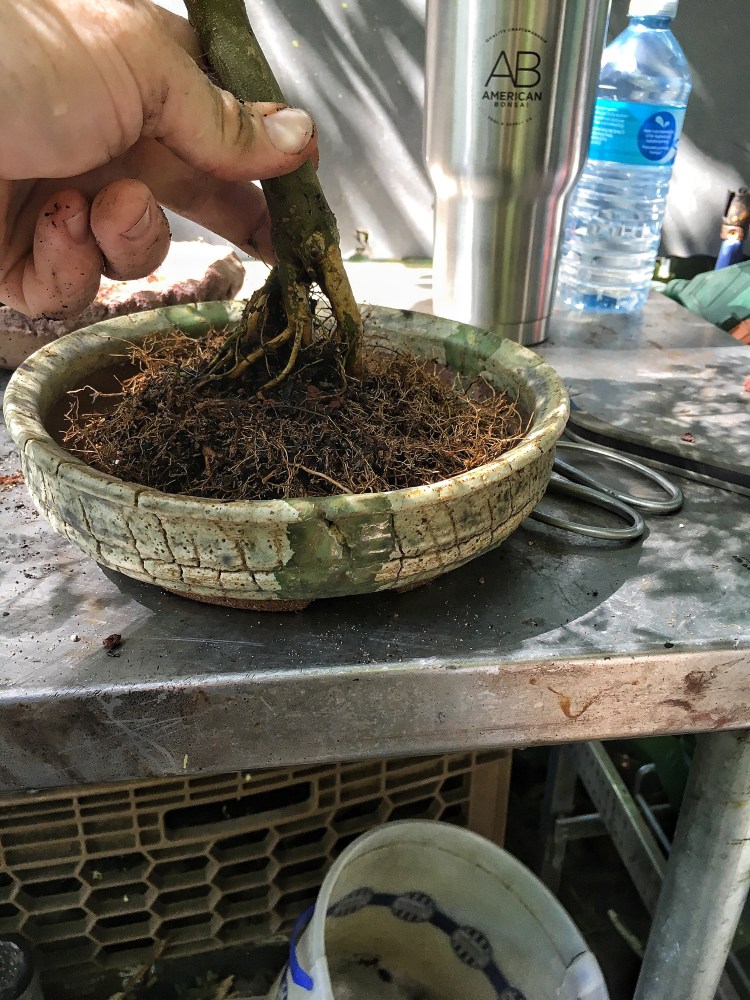
 As I figured, as much as I’d like to use my pot, I think it’s too shallow and not big enough. It’s the Cochoy pot then.
As I figured, as much as I’d like to use my pot, I think it’s too shallow and not big enough. It’s the Cochoy pot then. 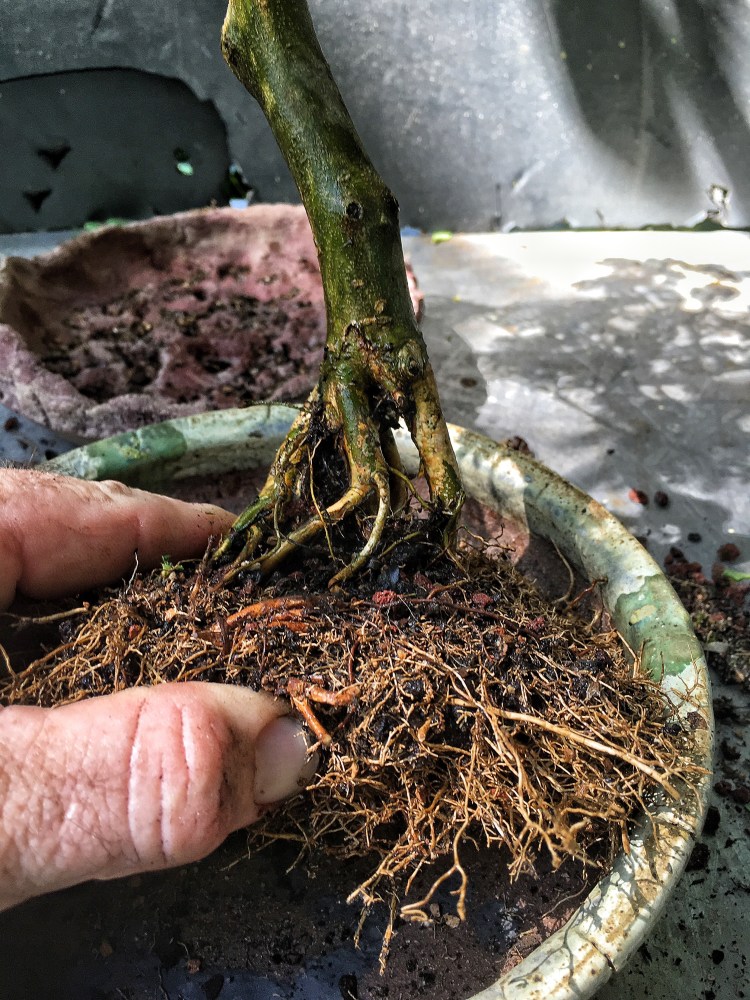 This tree looks like it was an air layered one. I suspect this because the roots emerge radially from the trees base. The BRT’s that were grown from seed have roots that tend to look like this:
This tree looks like it was an air layered one. I suspect this because the roots emerge radially from the trees base. The BRT’s that were grown from seed have roots that tend to look like this: 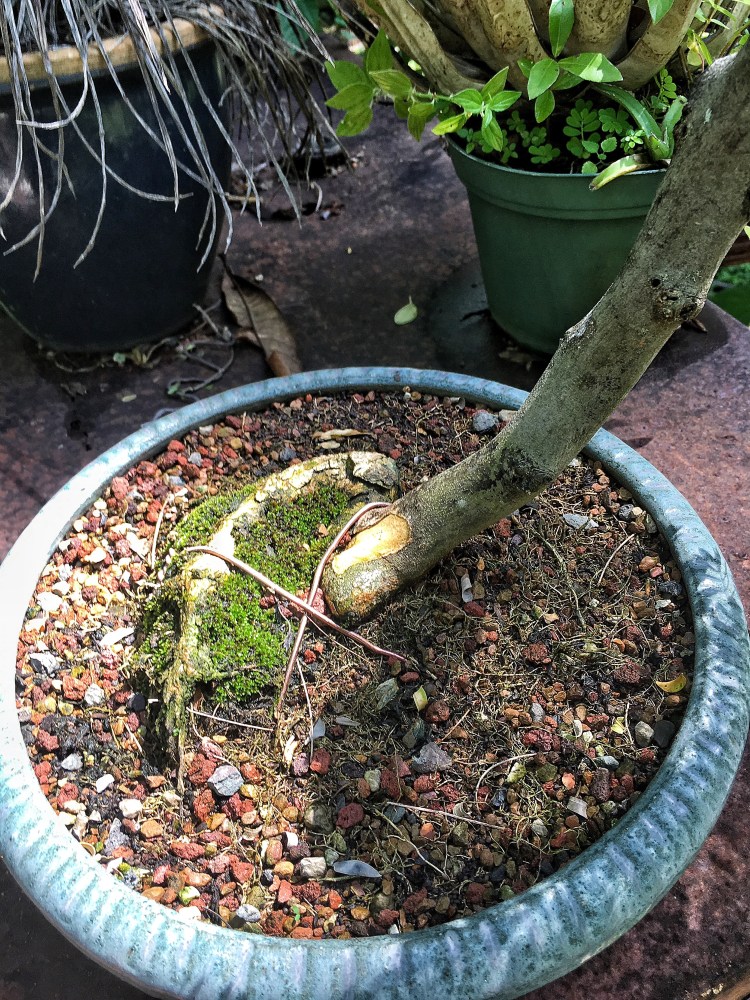
I’ll be working on this one soon as well.  It too needs a different pot.
It too needs a different pot.
New (and old) soil.
Ready for stylin’.
 Whenever I repot a BRT, I tend to defoliate it. This cuts down on transpiration stresses and also stimulates new growth; the tree gets “bumped” by the need of replacing the leaves and, therefore, stimulating new root growth.
Whenever I repot a BRT, I tend to defoliate it. This cuts down on transpiration stresses and also stimulates new growth; the tree gets “bumped” by the need of replacing the leaves and, therefore, stimulating new root growth.
 I also cut off the thorns. The tree doesn’t need a blood sacrifice and I’m no virgin anyway.
I also cut off the thorns. The tree doesn’t need a blood sacrifice and I’m no virgin anyway.
Now we are ready for some wire. 
And that’s it.
 I’ve just about run out of words. Amazing as that may sound. But I’ve run out of pictures too.
I’ve just about run out of words. Amazing as that may sound. But I’ve run out of pictures too.
I put a good handful of Milorganite, an organically derived source of nitrogen (I want slower growth on this tree, with the wire on it) and then the tree goes back into the full sun on its bench.
Yes, full sun. You hear that a newly repotted tree should go in the shade. The reason why we might put a tree in the shade after repotting is because, when you reduce roots, the tree has been diminished in its water uptaking abilities. But the way a tree uses water is through the process of transpiration. That happens in the leaves. And we defoliated the tree, therefore, no leaves, no water loss. Or very little. The water still evaporates. But the sun will stimulate all those latent buds that are no longer shaded by the leaves and it will be full of new growth in a week…….
One week later……
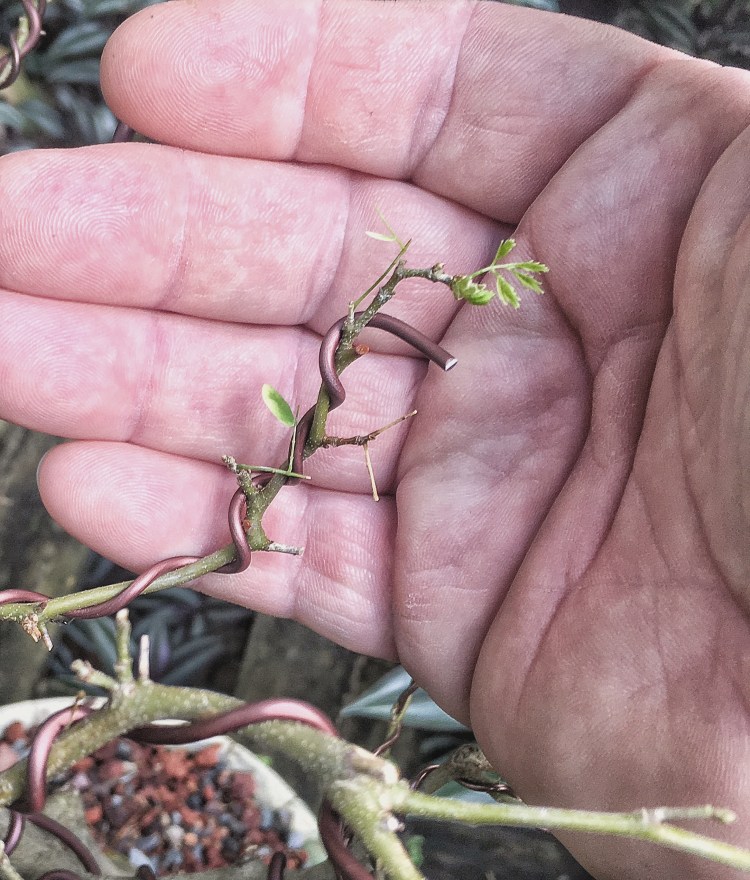 Ok, it’s not as dramatic as I was hoping but hey, it’s growing. Bob’s yer Uncle!
Ok, it’s not as dramatic as I was hoping but hey, it’s growing. Bob’s yer Uncle!
Next up I’ll think be working on some buttonwood. Repotting and maybe some carving. I’m going to Mary Madison’s tomorrow!

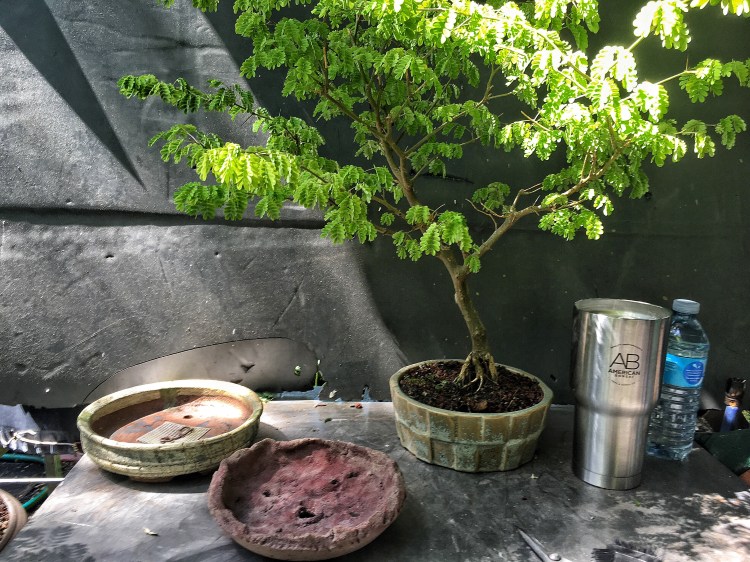
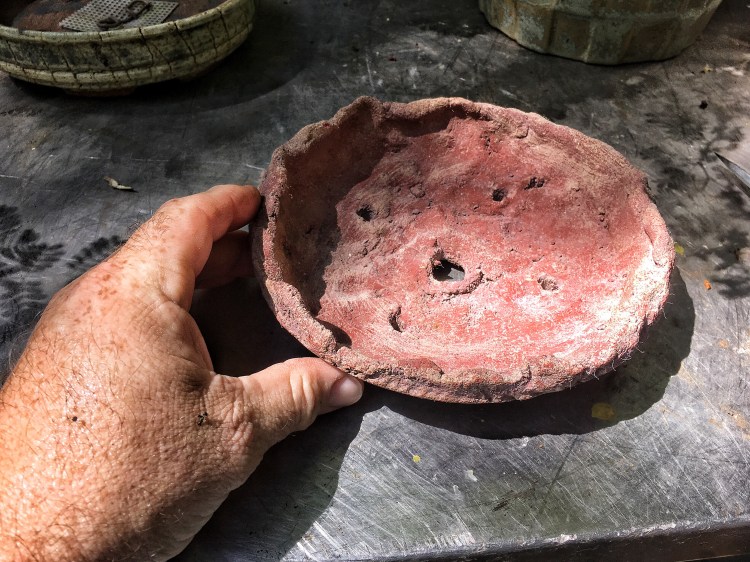







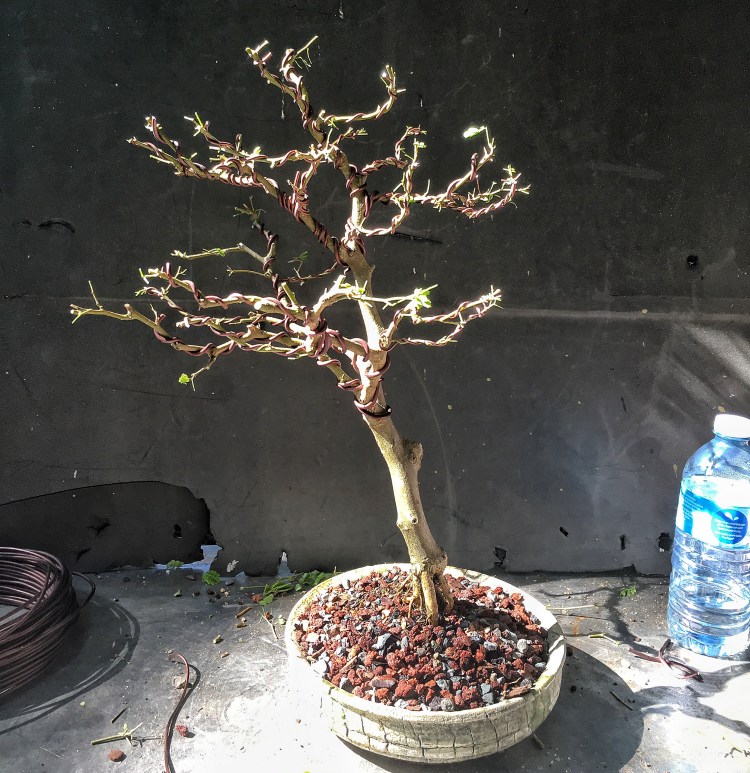

Reblogged this on Wolf's Birding and Bonsai Blog.
LikeLike
Nice post. Loved the bacteria and nitrogen uptake section. The final outcome of the tree is quite rewarding as well.
LikeLike
It is great to have articles on smaller trees for us newer to the art. And those of us who can not afford the big stock to work with. I grow a lot from cuttings or seed and have a long wait but I enjoy it. Sometimes it is hard to find any info on what to do with the small stuff. Thanks for all your knowledge and sharing it!
LikeLike
Great post Adam! Dito Nintai on the nitrogen cycle, uptake info. Thanks, you Rock, Paper, Scissors, Shoot! I accidently Googled pegging. Ouch!
LikeLike
Adam,
This email has nothing to do with the recent post. I have question about a previous one. You mentioned in a soil component discussion that you were going to try a product called Optisorb – diatomaceous earth. How did it work? Did it hold together or just get mushy? I was thinking of using it in place of pumice ( which we can not get locally) or perlite. Thanks for the info. By the way the blogs are great. Thank you for all of your hard work. No seriously – Thanks.
Joe Stumpf (from Jacksonville, FL)
>
LikeLike
It does not get mushy Joe, it’s very similar in hardness to turface. The particle size is similar too
LikeLike
HEY ADAM,
IS THE HONEY LOCUST TREE CONSIDERED A BRT, ITS HAS NASTY THORNS AND THE LEAFS ARE SIMILAR, I WANT TO BONSAI ONE CUS HOW GNARLY THEY ARE.
LikeLike
It is not the same, the Brazilian raintree is tropical and the honey locust is a temperate, deciduous tree native to the US. That doesn’t mean you can’t try it. They don’t grow here so I don’t know how well they do as bonsai
LikeLike
MAKES SENCE,
THANKS ! I WILL KEEP YA UPDATED WITH IT. ALLTHO I WILL HAVE TO START IT BY SEED, MY AIR LAYERING HAS NOT BEEN WORKING WITH ANY TREE I TRY IT WITH SO…. PLUS ISN’T ITS A LIL TO LATE TO SNIP A BRANCH TO ROOT?
LikeLike
The autumn is when you normally take hardwood cuttings actually. I’d just recommend getting one at a landscape nursery. Usually they’re on sale now
LikeLike
WELL THEY HAVE THE THORN LESS ONES. WAS TOLD THAT NO ONE LIKES HAVING IMPALEMENT HAZARDS IN THERE YARD. I THINK THEY MAKE A GREAT INTRUDER DENTURENT ….. HA HA ….. WELL HELL, I WILL GO GET SOME THIS WEEKEND. I FOUND A HUGE PATCH OF THEM NEAR BY.
THANKS AGAIN MY DUDE ! LOVE YOUR WORK,
OHH YEA!, DO YOU SELL ANY OF YOUR POTS, I’M IN NEED OF SOME.
NO ONE EVEN KNOWS WHAT A BONSAI TREE IS AROUND HERE.
LikeLike
What are your thoughts for having one of these trees in Utah? I will be able to house the plant inside during the winter under lighting.
LikeLike
I think it’s worth a try
LikeLike
Been working my way through your blog. As a new-to-the-game enthusiast, these have all been fun and helpful (and inspiring…the pics from events are awesome!). I’ve learned that 1). The “Ginseng” mall-sai I got from WalMart just might be more than an ugly duckling. and 2) the $20 “pre-bonsai” BRT that I got in October might be more exciting than I thought. Thanks. You give us newbies hope. Here in Ohio, I’m thinking that the raintree needs to hang out in it’s pot until spring, then I hope to move it to decent soil (again – thanks for the tips on composition), see what the roots look like and let the tree show me the direction it wants to go.
Do you take blog-topic requests? I am overwhelmed by the number of types of tools there are for working with bonsai trees. Can you do a little expose/teaching moment on which you use the most? Which are most versatile? What everyone should have in their kit-bag? kinda stuff?
LikeLike
You are welcome. I’ll try to work the tool (ahem) concept into a post here soon
LikeLike